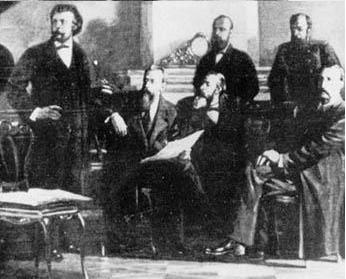|
| "Mighty Five" with Stasov |

|
| (L to R) Mussorgsky, Rimsky-Korsakov, Stasov, Balakirev, Cui, Borodin |
WHO:
- A circle of composers: Mily Balakirev (the leader), Alexander Borodin, César Cui, Modest Mussorgsky, and Nikolai Rimsky-Korsakov, who were self-taught composers
and professionally active in other fields.
WHAT:
- Exposed the world to the Russian East, which is full of supernaturalism, exoticism, Slavic pantheism, and vanished races.
The Russian folk music is rhythmically highly irregular.
- The self-conscious Russian music was based on: tonal mutability (a shifting tonal center); heterophony; parallel fifths,
fourths, and thirds; the whole-tone scale; and modular rotation in sequences of thirds.
WHEN:
- During the years 1856-1870
WHERE:
WHY:
- Inspired by Mikhail Glinka, they wanted to produce a uniquely Russian style of music, rather than something that followed
traditional European sound and convention. In doing this, they were the first composers in Europe to create an aesthetic completely
derived from nationalism.
HOW:
- Critic Vladimir V. Stasov (1824-1906) provided the expression "The Mighty Company" in a St. Petersburg newpaper article
on May 24, 1867. The article did not name the five composers, but they soon emerged with their Russian national
school.
|

